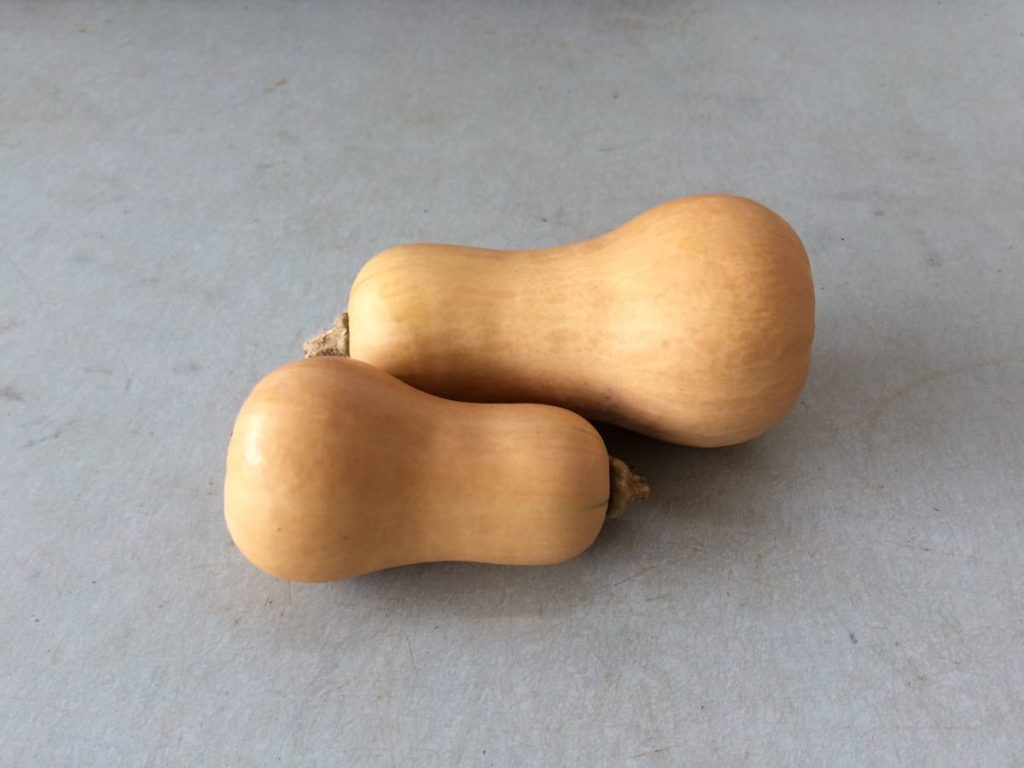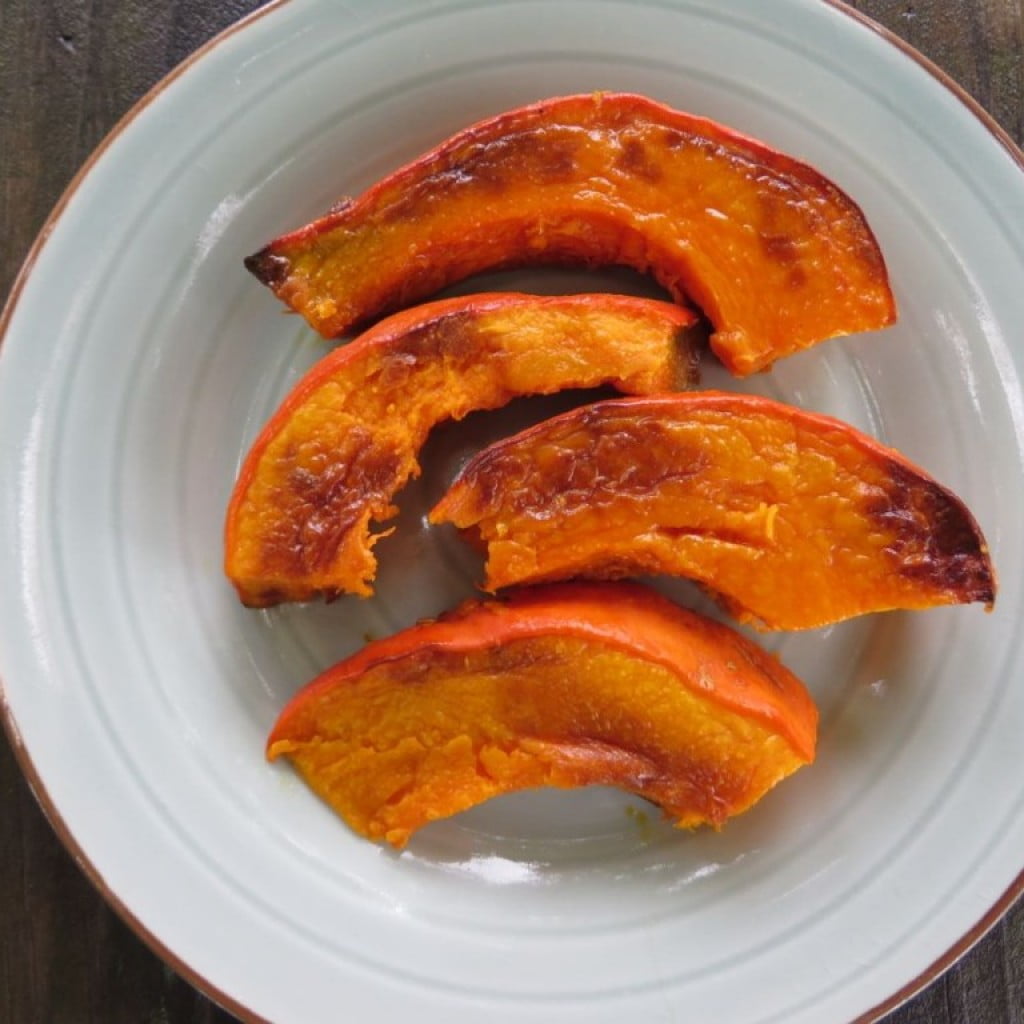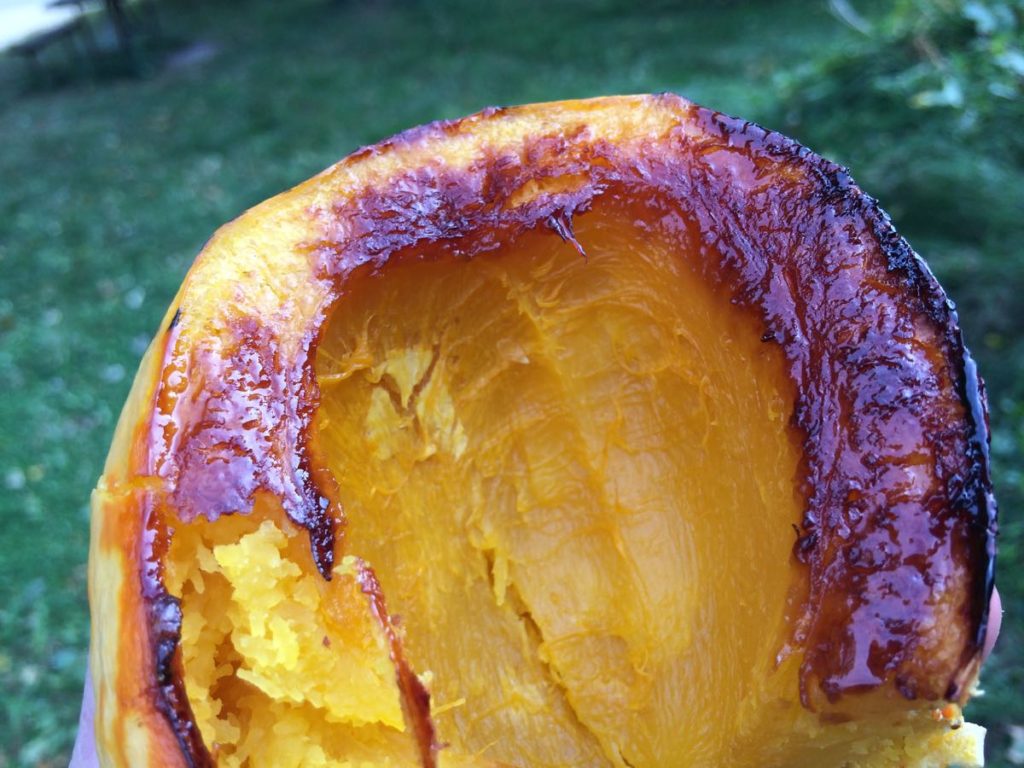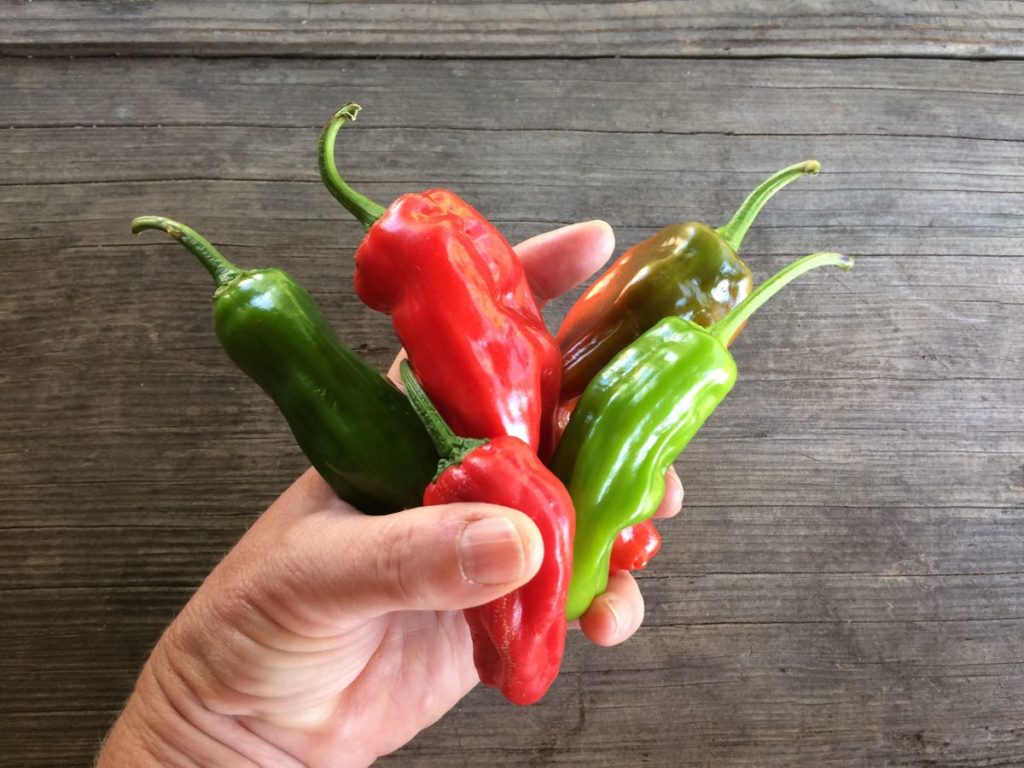Farm Newsletter
Week #19, Sept 27, 2018
- On: September 26, 2018
 1
1

From left, Noah Engel (Driftless Organics), Mike Nolterwyss (Crossroads Community Farm), Hans Bishop (PrairErth Farm), Steve and Raul Casique Montes (our farm).
Steve left at 5:30 this morning for a field day at our friends Hans and Katie Bishop’s farm in Illinois. The topic was mechanical weed control. Steve was in seventh heaven, checking out specialized machinery imported from Europe and watching tool demonstrations. “I got to meet the engineers who designed these pieces!” We spend so much time managing weeds that even small improvements are exciting. Steve carpooled with farmer friends Noah Engel, Mike Nolterwyss and our assistant farmer Raul. They had a great time hanging out during the seven hour round-trip. Sounds like 90% of the discussion was about farming and the remaining 10% gossip about other farmers.
We hosted UW beet trials again
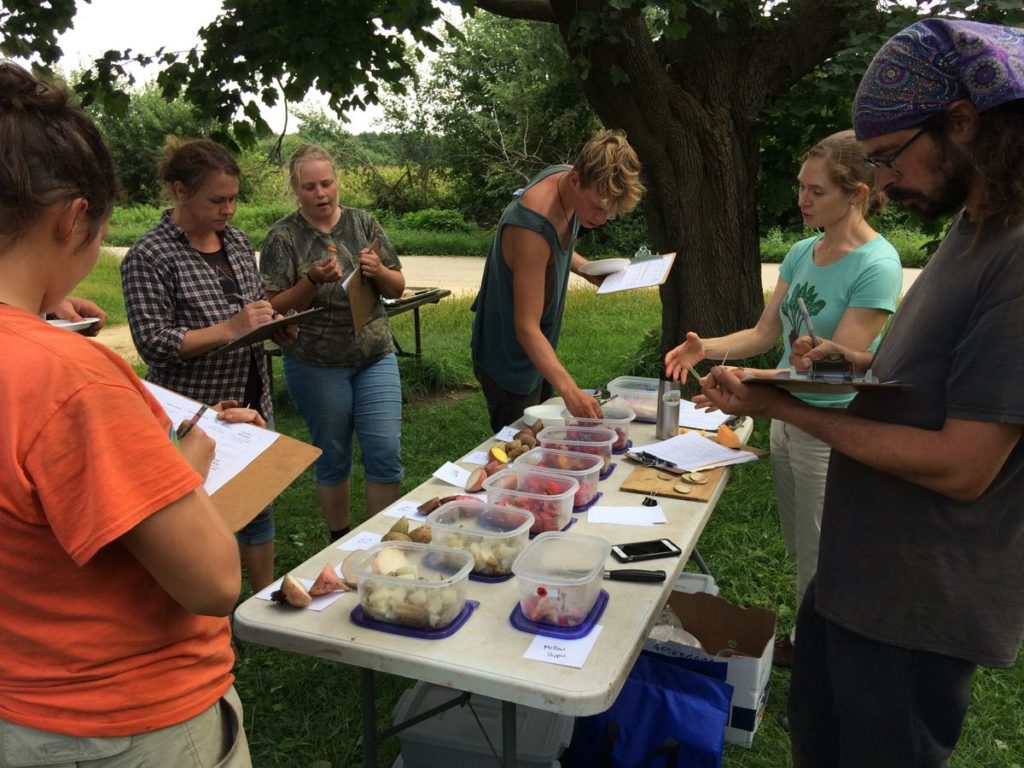
Tipi crew members evaluate beet breeding lines selected at our farm by UW grad student Solveig Hanson, second from right.
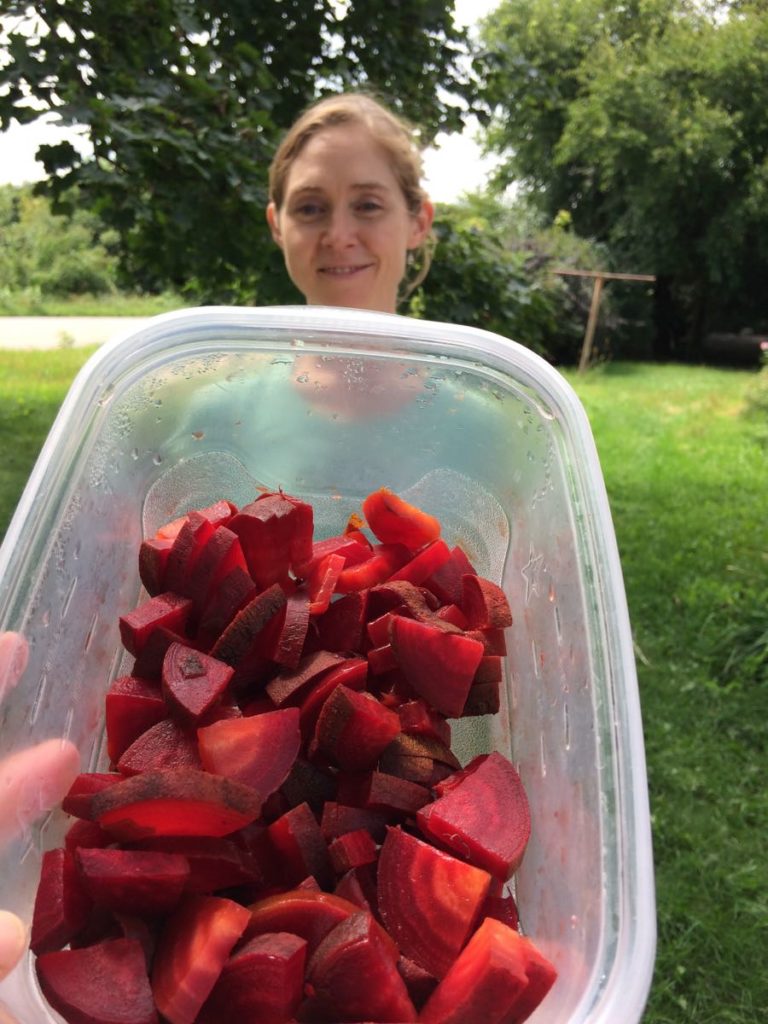
Solveig with a vivid orange-fuschia beet line.
Once again, we hosted research trials this summer for UW graduate student Solveig Hanson, who is breeding beets for specific flavor and color profiles. Many of you have given input on this project. At last year’s gleaning party, Solveig brought beet samples for Tipi CSA members to evaluate. She used your opinions (among others) to hone her lines. She is selecting beets for different levels of the ‘earthy’ flavor that some people like and some people don’t.
Solveig returned to the farm this fall so our work crew could evaluate the updated breeding lines. The range of flavors is quite interesting. As a group, we are a mix of beet-lovers, beet-haters and beet-ambivalent types. Almost everyone found a breeding line they found appealing. Solveig plans to sample beets again at our gleaning party this year.
Veggie List and Veggie Notes
Week #19, Sept 27/28, 2018
Weekly and green EOW
Green cabbage
Bok choy or tat soi, 1 medium
Acorn winter squash, 1 or 2
Frying &/or bell peppers, ~2
Oranos snack pepper, ~1
Poblano chiles, 3
Yellow onions, ~2
Basil, the last sprig of the year
Each site gets 1 or 2 of these:
Broccoli OR cauliflower OR eggplant OR zucchini OR orange snack peppers
Next week’s box will probably contain yellow potatoes, green beans, carrots, peppers, leeks and more.
Green cabbage – Here’s a crop that’s done very well. These are substantial. Storage: Refrigerate. It’s OK to cut off chunks as needed, then store the leftover head in your crisper drawer. If you plan to use again within a week, you don’t need to cover the cut head. Next time you use the cabbage, shave off and discard the cut surface.
Bok choy or tat soi – These nutritious greens are interchangeable in recipes. Bok choy has thicker white midveins, tat soi has smaller, darker, more abundant leaves.
Acorn winter squash – You’ll get one or two acorn squash. Most people get Festival, a very tasty variety. Some get one of the other types in the photo below. All are cured and ready to eat. Store on your kitchen counter and keep an eye on them. They look good now but might not last. Wet weather as the squash matured makes them unpredictable now. They sure taste good!
Poblano chiles (triangular, shiny, dark green) – This week’s poblano variety is spicier than the one we sent three weeks ago.

You’ll get one or two of these types. Clockwise from top left:
– Festival, a very tasty acorn squash.
– Celebration, a new type we’re trialling this year. Can you distinguish Celebration from Festival? Neither can we.
– Jester, a favorite acorn x sweet dumpling cross. This one is more oblong.
– Heart of Gold, another promising new acorn we’re trialling this year. This variety is green and white with a little orange but no yellow.
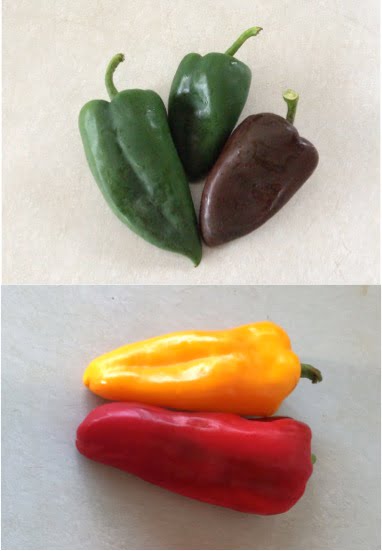
Poblano chiles (top) versus frying peppers (bottom). Poblanos are darker and triangular. They will be all green, or chocolate-brown, or green with a red tip. Frying peppers are longer, and will be red or yellow, some peppers mixed with green.
RECIPES
Visit our 2018 Recipe Log or our 2017 Recipe Log or join our Facebook discussion group.
LOCAL THYME/ Comforting Classics
Simple Sesame Soy Choy Pepper Sauté
Cabbage and Onions with Caraway
Chicken Tacos with Shredded Poblanos and Cabbage in Chipotle Crema
Honey Soy Glazed Winter Squash Rings
LOCAL THYME/ Outside the Box Recipes
Miso Grilled Tatsoi or Bok Choy
Sweet Salt-Pickled Cabbage
Rigatoni with Cabbage and Meat Sauce
Lasagna Stuffed Acorn Squash
LOCAL THYME/ Quick & Easy Meal
Winter Squash and Poblano Posole with Black Beans
RECIPES FROM LAUREN
CABBAGE & POBLANO RUNZA
What the heck is runza you ask? Well, officially, it is the state dish of Nebraska. But closer to home, it is a dish I grew up with when my mom had extra cabbage in her garden. It’s essentially a German-style calzone packed full of ground meat (traditionally beef, but here I used pork because it’s what I had on hand), cabbage, and onions. Poblanos are a fun addition and you could even throw more peppers in there if you wanted to. I know making your own dough can seem intimidating but give it a try. It’s easier than you think. Lauren.
Makes 8 runzas
Takes 2 hours
Dough:
3/4 cup lukewarm water
2-1/4 teaspoons active yeast
Pinch sugar + 3 tablespoons sugar, divided
4 eggs; 3 for dough, 1 for egg wash
4 cups all-purpose flour, divided + more for dusting counter
12 tablespoons butter, softened
2 teaspoons Kosher salt
Filling:
1 tablespoon olive oil
1 pound ground pork
1 teaspoon Kosher salt, divided
1/2 teaspoon black pepper
1 medium (or 1/2 large) yellow onion, sliced
2 poblanos, diced
2 tablespoons butter
1/2 head cabbage, shredded
1 teaspoon dried thyme
1/2 teaspoon dried sage
- In a large bowl, combine water (it should be warm but not hot), yeast and sugar. Whisk gently to combine. Let sit for 10 minutes until it bubbles, rises and smells yeasty. Add 3 eggs and whisk to combine. Add half the flour and beat with a spoon until totally incorporated. Add butter, remaining flour, sugar and salt. Stir until just combined and then let rest for 15 minutes.
- Once rested, dust counter with flour and knead dough for 5 minutes until tight and smooth. Transfer the dough to a clean, greased bowl. Cover with plastic wrap and let rise in a warm space for an hour (until doubled in size).
- When the dough is about 20 minutes from finished, preheat the oven to 375 degrees and start on the filling. In a large heavy skillet (or Dutch oven), heat olive oil over medium heat. Add ground pork, 1/2 teaspoon salt and the pepper. Break up meat with two forks, cooking for 5 minutes until browned. Add onion and pepper. Cook 5 minutes more. Add butter and remaining salt to skillet. Get it a stir so the butter coats all the meat and veggies. Add cabbage along with dried herbs and let wilt gently over medium low heat for 15 minutes.
- At this point, your dough should be risen. Grease two baking sheets. Divide into 8 pieces.
- Re-dust counter with flour and roll out dough into a rough 8×4-inch rectangle. Scoop 3/4 cup of cabbage mixture into the center. Fold in the two long sides of dough so they touch then pull the other edges into the center until you form a sealed dough pocket with the meat in the middle. Place, seal side down, on the greased baking sheet. Repeat with remaining dough and cabbage mixture.
- Beat last egg in a small bowl until smooth and brush runzas with egg mixture.
- Bake for 15 minutes. Rotate pans and bake 15 minutes longer until golden brown.
.
FALL SQUASH CURRY
I know a lot of you aren’t receiving eggplant this week. If you have some in your fridge from last week, use that! Otherwise, just skip the eggplant or feel free to substitute zucchini or cauliflower. This recipe is incredibly versatile so you can adjust the veggies a bit based on what you have on hand. Lauren.
Serves 6-8
Takes 50 minutes
2 tablespoons coconut oil (or olive oil or butter)
1 yellow onion, diced
1 medium head bok choy (if you got two small heads, use about 75% of them), leaves roughly chopped and stems sliced
1/2 teaspoon Kosher salt
1-2 acorn squash (whatever you received this week), halved, seeded and cut into 1-inch cubes
1 pound eggplant, cut into 1/2-inch cubes (optional)
1 colored bell pepper, diced
1 orano, diced
1-inch piece ginger, peeled and minced
5 tablespoons red curry paste
2 tablespoons brown sugar
1 tablespoon curry powder
2 cups chicken (or vegetable) broth
Two 13.5-ounce cans full-fat coconut milk
2 tablespoons fish sauce
5-6 cups cooked rice
Sriracha, optional
Lime wedges, optional
- In a large stock pot, heat oil over medium high heat. Add onion to pot followed by bok choy stems and salt. Cook, stirring occasionally for 10 minutes. Reduce heat to medium. Add squash, eggplant, if using, peppers, and ginger. Cook, stirring occasionally, for 10 minutes longer until squash is just beginning to soften.
- Add red curry paste, brown sugar and curry powder. Stir until it evenly coats the vegetables and cook 5 minutes longer until fragrant.
- Add broth and coconut milk to pot. Bring to a boil, reduce heat to medium low and cook for 15 minutes. Add bok choy greens and fish sauce. Cook until greens are just wilted, about 3 minutes. Taste and adjust seasonings as needed. This curry as written isn’t super spicy so you may want to add sriracha.
- Serve over rice with lime wedges.
.
Week #18, Sept 20, 2018
- On: September 19, 2018
 0
0
This week’s winter squash
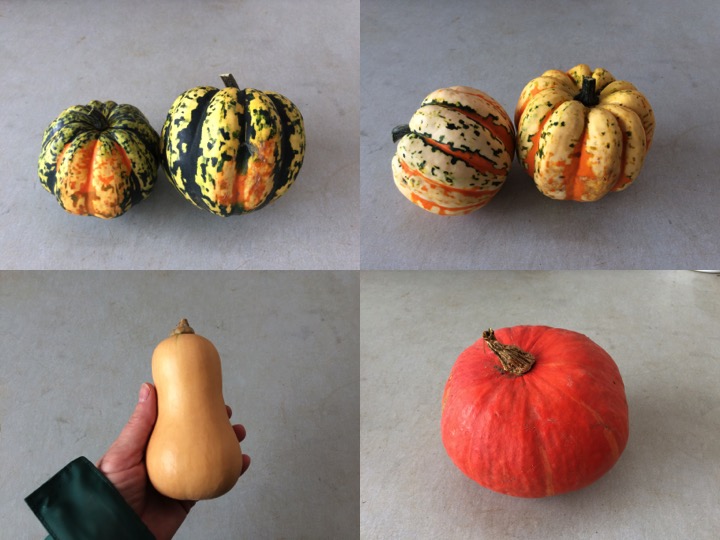
Clockwise from top left, ‘Carnival’ acorn, ‘Festival’ acorn, ‘Sunshine’ kabocha, ‘Butterscotch’ butternut
Almost everyone gets one or two acorn squash this week. One site gets Sunshine and another gets Butterscotch. All are cured and ready to eat.
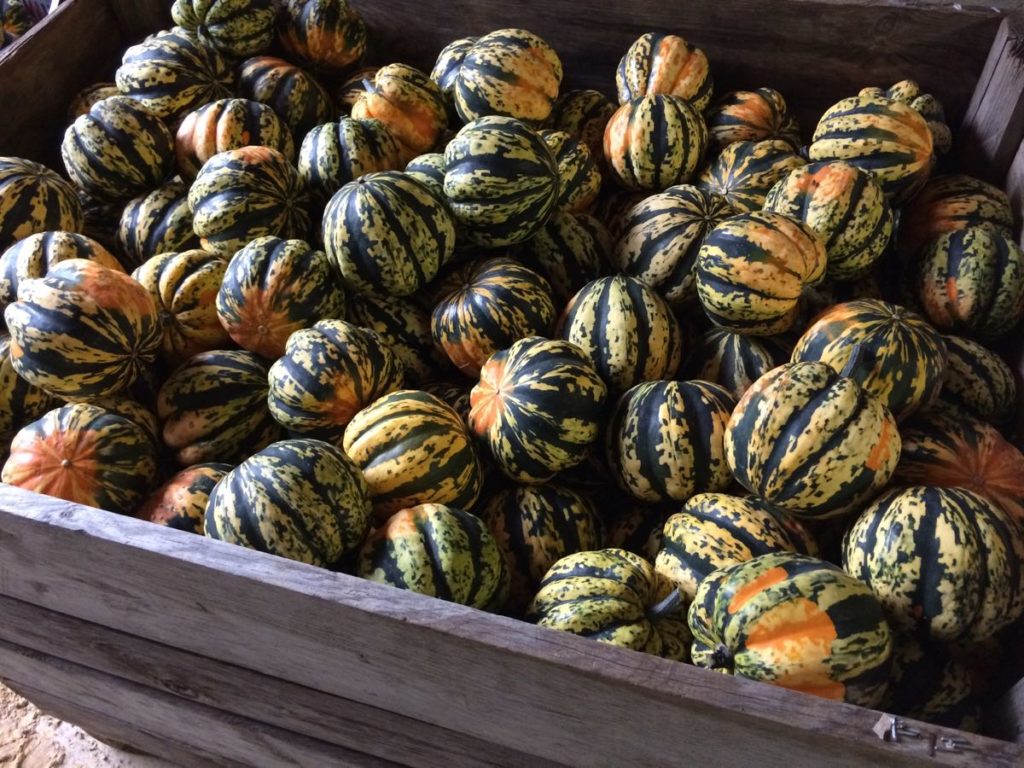
A wooden bin of Carnival squash
Acorn squash (Carnival, Festival this week) – These are distractingly beautiful, with stripes and patterns in yellow, green, orange and white. We used to grow all-green acorn squash but stopped because we think the newer striped varieties taste better and are the plants are more vigorous.
Preparation: Acorn squash have a central cavity perfect for stuffing. Prepare your favorite fully-cooked stuffing, e.g. a rice or quinoa mixture. Roast your squash as described below. Preheat the stuffing. Fill the cooked squash with stuffing, top with grated cheese and return to the oven until everything is hot.
Butterscotch butternut – These small (tiny?) squash are incredibly sweet and flavorful. We grew them as a test this year. We love the flavor, but are ambivalent about how small these ‘personal size’ squash are.
Preparation: Roast and eat with salt and pepper. They don’t need any embellishment.
Sunshine – Bright orange Sunshine have a mild, sweet flavor reminiscent of chestnuts. The skins are tender and edible. We find that Sunshine do not store well, because of the thin skins. Eat these soon.
Preparation: (i) Dry roasting brings out Sunshine’s delicate flavor. Cut into thick slices, toss with olive oil, and roast on a well-oiled cookie sheet at 425 oF until soft. The slices will fall apart if you overcook them but you have a fairly wide window to get them out of the oven successfully. Make sure to roast them until the cut surfaces are caramelized. Season with salt after they are out of the oven. Excellent with a yogurt-garlic-olive oil dip.
(ii) Sunshine have a central cavity amenable to stuffing. See acorn squash above.
Winter Squash Primer
This year’s winter squash crop is excellent. The dry spell was perfectly timed to bring in the squash without damage. We should have enough for a steady supply of squash or sweet potatoes over the coming weeks.
Expected life: Some winter squash varieties are ready to eat soon after harvest, others store deep into winter. This week’s varieties are cured and ready to eat. Plan to eat these early varieties within two to four weeks, on the shorter side for the kabocha.
Storage: Winter squash store best at room temperature with good air circulation. No cooler than 50 degrees. On your kitchen counter works. Do not cover.
To make squash easier to cut: Microwave on high for 30 to 60 seconds, depending on size of the squash. This will soften the rind and flesh, making it much easier to cut.
Beth’s favorite simple preparation (acorn or butternut): Winter squash are easily roasted in a 400F oven.
– Split in half with a sharp knife.
– Scoop out and discard seeds.
– Run the squash briefly under running water, then shake off the excess water. Place cavity-side-down on an oiled baking sheet. The little bit of moisture seals the squash to your roasting pan. The water soon evaporates, allowing the squash to brown and caramelize. Caramelization really boosts the flavor.
– Roast at 400F until easily pierced with a fork, 30 – 45 minutes depending on size. Flip over while hot. Add a little butter to melt and some seasoned salt. Cut into wedges and eat.
Can you eat the rind? Kabocha rind is thin and edible. Rinds for acorns and butternuts are thicker. It’s your choice whether to eat them or not. Steve eats them. I don’t.
Veggie List and Veggie Notes
Week #18; Sept. 20/21, 2018
Weekly, purple EOW, and sun SMP shares
Broccoli
Cauliflower
Winter squash, 1 or 2
Kale, 1 big bunch
Romano beans, 0.9 – 1 lb
Grape or cherry tomatoes, 1 pint
Bell or frying pepper, 1
Yellow onions, ~2
Jalapeno chile
– Some sites get 1 – 2 zucchini.
– Some sites get globe eggplant.
Next week’s box will probably contain green cabbage, winter squash, broccoli, bok choy, peppers, onions and more.
RECIPES
Visit our 2018 Recipe Log or our 2017 Recipe Log or join our Facebook discussion group.
ROMANO BEAN RECIPES
This week’s beans are suited to braising. Let’s gather and repeat last week’s recipe links, so you don’t have to hunt for them.
– Lauren’s favorite: African Peanut Stew .
– Former crew member Jon Fagan’s favorite: Braised Green Beans with Tomato and Fennel Seeds (in previous newsletter, scroll down).
– Beth’s favorite: Sausages and Summer Beans with Tomatoes & Caramelized Onions. (in previous newsletter, scroll down).
– Lemony Braised Romano Beans
– Romano Bean, Potato and Meatball Stew
LOCAL THYME/ Comforting Classics
Cheesey Cauliflower Pasta
Easy Pot Pie
Quick Honey Nut Acorn Squash
Garlic Parmesan Kale Chips
LOCAL THYME/ Outside the Box Recipes
Cauliflower Gallette Crust
Sweet Spicy Broccoli and Pepper Stir Fry
Acorn Squash and Caramelized Onion Pizza
Kale Broccoli Soup
LOCAL THYME/ Quick & Easy Meal
Fish Tacos with Cherry Tomato and Pepper Salsa
RECIPES FROM LAUREN
SLOW COOKER CARAMELIZED PORK RAMEN WITH CURRY ROASTED VEGETABLES
Adapted from Half Baked Harvest
If you aren’t a person who loves big, bold flavors, well then this recipe may not be for you. Ramen like this is certainly not for the faint of heart. It has a lot of spice, a lot of salt, and a lot of richness. It is also incredible. But if flavors that big aren’t you thing, well then maybe just make the slow cooker pork and make the roasted vegetables and eat them sans noodles and sans broth. The broth is where the big, bold flavors are hidden. Lauren.
Serves 8-10.
Takes a long time (because slow cooker), but I recommend estimating about an hour of active cooking time + 4 (or more) hours in the slow cooker.
2-3 pound pork shoulder roast, bone-in or out is fine
1 red pepper, seeded and cut into long, skinny strips
1 yellow onion, divided
6 cups water
1/2 cup soy sauce (or tamari) + 5 tablespoons, divided
1/4 cup rice wine vinegar + 2 tablespoons, divided
3 tablespoons fish sauce, divided
1 tablespoon sambal oelek or sambal nyonya (or other hot sauce that you happen to have on hand)
1 lime, juiced
1 tablespoon Kosher salt
1 teaspoon black pepper
5 tablespoons brown sugar, divided
3 tablespoons + 1 teaspoon curry powder, divided
1 teaspoon ground allspice
1 teaspoon ground ginger
1/2 teaspoon ground coriander
1/2 teaspoon ground cumin
1/2 teaspoon cinnamon
1/4 teaspoon ground cloves
4-5 cups chopped acorn squash, seeded first (1 large squash)
4 cups chopped cauliflower (1 medium head)
1 zucchini, halved and sliced
1/4 cup olive oil
2 tablespoons toasted sesame oil
6-8 ounces ramen noodles (real ones from the Asian market or plain old ramen packets with the flavor packets removed are both fine)
1 jalapeno, thinly sliced, optional
Soft-boiled eggs (if you’re feeling extra ambitious), optional
- Get your slow cooker going. Add the pork roast to the center. Cut onion in half. Set aside one half to thinly slice just before serving. Dice other half onion and nestle around pork in slow cooker along with peppers.
- Pour water, 1/2 cup soy sauce, 1/4 cup rice wine vinegar, 2 tablespoons fish sauce, sambal oelek (or hot sauce), and lime juice into slow cooker. Add salt, pepper, 1 tablespoon brown sugar, 1 teaspoon curry powder and the rest of the spices. Give things a quick stir.
- Cover the slow cooker and cook on high for 4-6 hours or low for 6-8 hours. If you have more time than that, just turn it to keep warm after the initial 8 hours. I tend to do the first cooking over night and then leave it on low all day while I’m at work. Extra steeping won’t hurt you here, I promise.
- About an hour before you are ready to serve your ramen, preheat the oven to 400 degrees.
- Toss acorn squash, cauliflower and zucchini with olive oil, 3 tablespoons brown sugar, 1 tablespoon soy sauce, and remaining curry powder (3 tablespoons) and fish sauce (1 tablespoon) in a large bowl. Lay out on two large baking sheets. Bake in preheated oven for 50-60 minutes, rotating pans and vegetables throughout cooking at least once.
- While that roasts, and once the pork is finished cooking, remove from slow cooker. Remove any bones and shred with two forks. Add ramen noodles and cook on high for 12 minutes. Once finished, add back half the shredded pork and reduce heat to “keep warm” setting.
- In a large skillet, heat sesame oil over medium heat. Add other half shredded pork followed by the remaining brown sugar (1 tablespoons), soy sauce (2 tablespoons) and rice wine vinegar (2 tablespoons). Cook for 10 minutes, stirring every couple minutes so the bottom layer of pork gets crispy and almost caramelized.
- Serve ramen soup with crispy pork, roasted veggies, and raw sliced onion as well as jalapeno and soft-boiled eggs (if using).
.
BROCCOLI & KALE SALAD WITH FRIED ONIONS & PEANUTS
The two recipes this week really pair wonderfully together using several similar ingredients so use this week’s box as an excuse to go out a buy bottles of rice wine vinegar and higher quality fish sauce! Lauren.
Takes 25 minutes.
Serves 2 as a meal or 4 as a side dish.
Vegetable oil
1 large onion, halved and sliced
1/2 cup flour
2 tablespoons Kosher salt
1 head broccoli
3-4 stems curly kale, stems removed and chopped small
1/4 cup peanut oil (don’t have peanut oil? use 1/4 cup of the oil you fried your onions in instead)
1/4 cup rice wine vinegar
1 tablespoon brown sugar
2 teaspoons fish sauce
3/4 cup roasted peanuts, roughly chopped
Pinch red pepper flakes, to taste
- In a large skillet heat 2 inches of vegetable oil over medium high heat.
- While the oil warms, prepare your onions. In a small bowl, toss onion with flour and salt until well coated.
- Once oil is just starting to glisten, it is at the right temperature. Add half the onions and use a fork to make sure all the onions are submerged. Fry until golden brown, about 4-5 minutes. Drain on paper towels. Fry second half of onions and drain as before. Leave onions while you prepare your salad.
- Cut your broccoli by removing 3-4 inches of the stem and then cutting the head in half. Slice the head thinly so you end up with long, elegant pieces of broccoli. Place in large bowl with the kale.
- In a small bowl, combine peanut oil, vinegar, brown sugar and fish sauce. Whisk until smooth. Pour over vegetables and massage until uniform and well-coated.
- Serve salads with fried onions, peanuts and red pepper flakes. Taste and season with salt and pepper as desired. If eating part of the salad later, store separate from peanuts and fried onions so they don’t lose their crunch.
.
Week #17, Sept 13, 2018
- On: September 12, 2018
 2
2
Farm News
This was a nice week. Sunny and mild, it was just what we needed. To follow up last week’s newsletter, no one quit, not even Steve. We thought about it during the incessant rain.
This has been a productive week. Too many jobs were impossible during the rain and we haven’t put a tractor in the fields for weeks. We were all quite motivated once the weather cleared. Steve, Raul and Roger focussed on field work, cultivating, mowing and even doing some tillage. The first winter squash are harvested and curing for next week’s boxes. The winter squash crop is my baby so the early harvest makes me happy. Beth
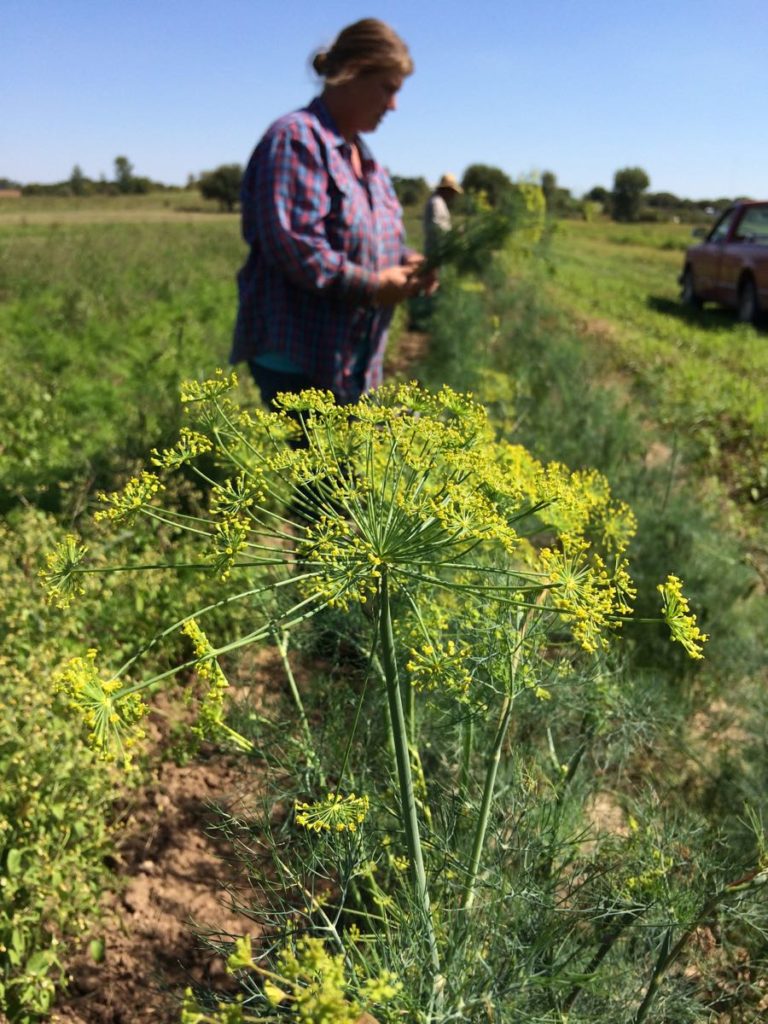
Maggie and Charlotte pick dill bunches. Maggie puts dill flower bouquets on her kids’ nightstands, to sooth nightmares and help them sleep.
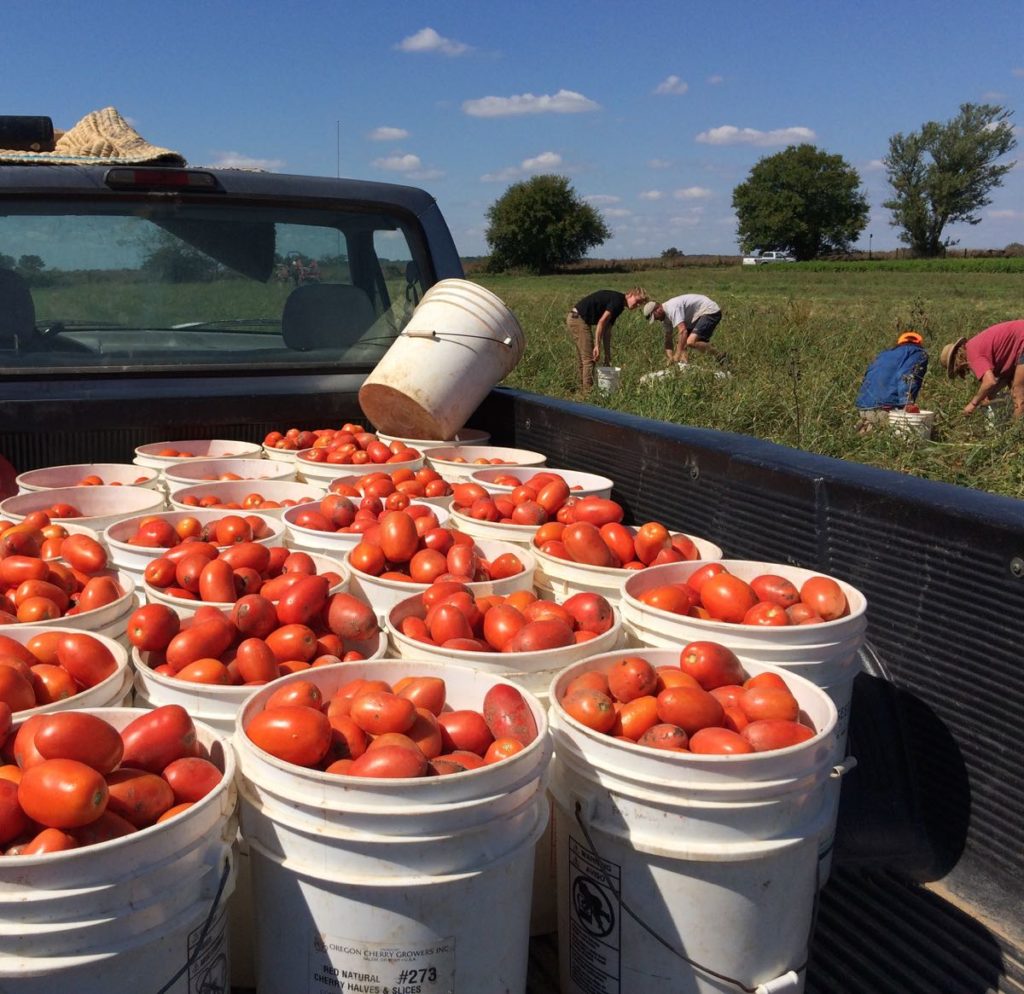
We are still harvesting good plum tomatoes from one variety in a field that was otherwise overwhelmed by rain. See the pail tilted at top?

The crew broadcasts music from their phones with this “speaker pail.” This is low-tech but it works!
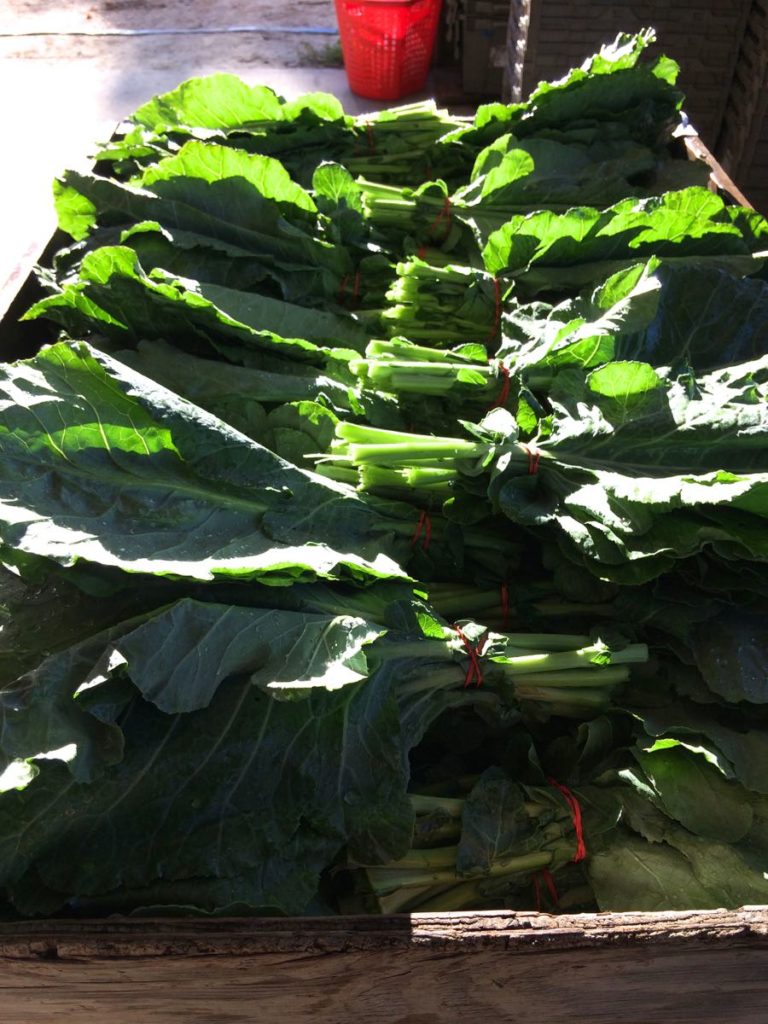
Collard greens glowing in the sun.
Let’s talk Romano beans.
Romano beans are more robust and meaty than green beans. They are excellent raw but really shine when gently cooked for a long time. Pat and Lauren both have good recipes below. I notice that most people who love Romano beans are dedicated to a particular recipe. There’s overlap between these recipes, but here goes:
– Lauren asked me to remind you about last year’s African Peanut Stew recipe, which is easily adapted for this week’s veggies. It’s an excellent recipe for this time of year.
– Former Tipi crew member Jon Fagan raves about Braised Green Beans with Tomato and Fennel Seeds (in previous newsletter, scroll down).
– My favorite Romano bean recipe (which I recommend every year but also look forward to every year!) is Sausages and Summer Beans with Tomatoes & Caramelized Onions.
– Finally, here’s a 2017 quote from Tipi member Steve Rankin:
“You have finally sold me. I have never been a fan of Romano beans. This week I have been sautéing them with various peppers and garlic, as well as the oregano from earlier this season. They are especially tasty with Poblanos. Lots of black pepper and some soy sauce, which make the pan sticky. I deglaze the pan with wine and braise them in the wine. I’m sold!”
Some of you might have poblanos from last week. Otherwise this week’s shishitos will be a good addition to Steve R’s approach. Beth.
Everything I know about shishito peppers
This is our first year growing shishito peppers. Look for a handful of shishitos in your bag of beans, where they are easy to find and recognize. I hesitate to spend a lot of time on such a small amount of food but these are new and interesting. We’ll send them again in a few weeks. You will receive green and/or red ones. Some of the most tasty ones are the soft, full-ripe red ones. They get leathery but are delicious. There are reports online that a low percentage of shishitos will be spicy. We have not encountered that yet. Here’s the lowdown from Johnny’s Seeds:
“Heavily wrinkled fruits are thin walled, mild (no heat) when green and slightly sweet when red. Popular in Japan where its thin walls make it particularly suitable for tempura. Also very good in stir fries or sautés. In Asia, fruits are always cooked green but they also may be used red. Thinly sliced, the red fruits are excellent in salads and coleslaw.”
Blistered shishitos. If you search “shishito recipe,” almost all results are for blistered shishitos. Here’s my version, courtesy of Lauren. She puts blistered shishitos on hamburgers, I add them to grilled cheese sandwiches, and you can use them to top any dish.
1. Cut the caps off your shishito peppers. Trim the core with the tip of a paring knife. Flick or shake out the seeds.
2. Heat a little grapeseed oil in a skillet until it’s hot but not smoking. Add peppers. Cook over medium-high heat, turning occasionally until they blister in a few places. They don’t need to be blackened, just a few charred spots. This is quick, about 3 – 6 minutes. Don’t peel – they are too thin-walled.
Alternatively, you can grill them or put your cast iron skillet under the broiler.
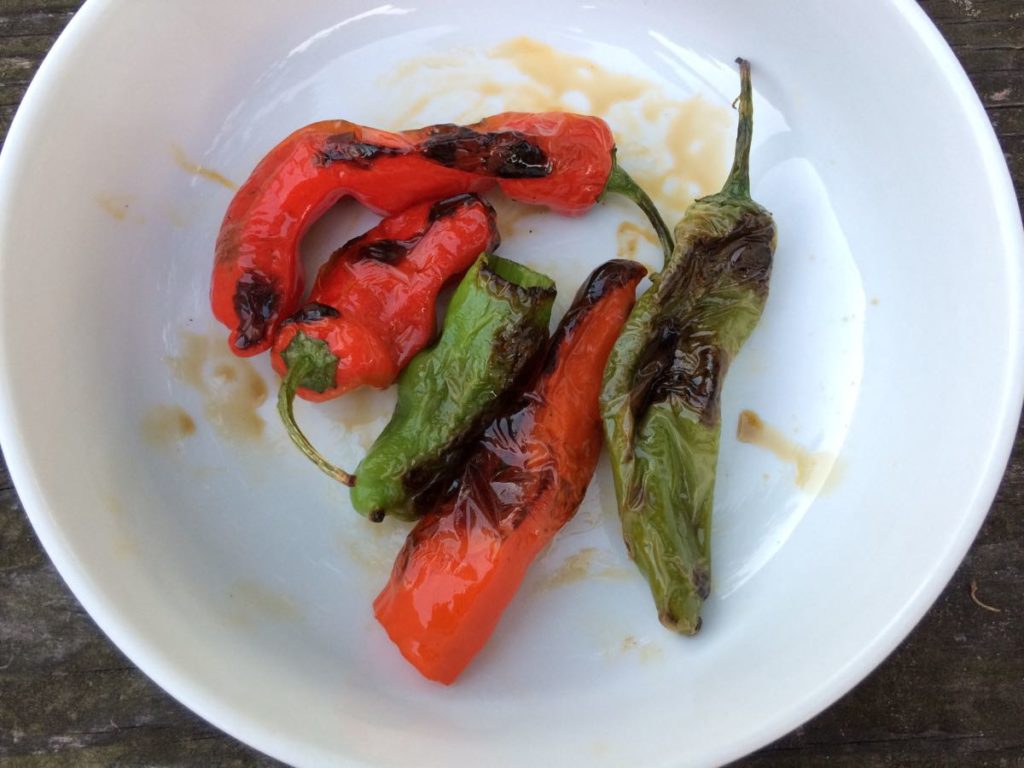
I tried cooking intact shishitos versus ones that were capped and seeds removed. I like the latter. Then the peppers are ready to use once blistered.
Veggie List and Veggie Notes
Week #17, Sept 13/14, 2018
Weekly and green EOW shares
Red potatoes, ~3.5 lb
Romano beans, 1.4 lb
Collard greens, 1 bunch
Bell or frying pepper, 1 – 2
Shishito peppers, a handful
(in bag with Romano beans)
Plum tomatoes, 2.9 lb
Yellow onions
Dillweed & flowers, 1 bunch
– By site, you’ll get broccoli OR cauliflower OR eggplant.
– By site, you’ll get 1 zucchini OR 1 frying pepper or Oranos peppers.
Next week’s box will probably contain cabbage, winter squash, peppers, (cauliflower or broccoli or eggplant), peppers and more.
Red potatoes – These were grown by our friends Josh and Noah Engel of Driftless Organics, or as Steve says “the Engel boys.” He knew them as kids when he farmed in the Driftless area and carpooled with the Engel family to Pleasant Ridge Waldorf school in Viroqua. Now they are all grown up with families of their own and a thriving farm.
Collard greens – This is the first picking from a fresh field, so quality and texture are excellent. Collards are as nutritious and versatile as their close relative, kale. Use interchangeably in kale recipes. Storage: Cover and refrigerate.
Plum tomatoes – This week’s plum tomatoes are good, better than the last few weeks. These are from a sturdy variety called “Granadero” which really shone this year. It kept healthy leaves despite all the rain. That’s how you get tasty tomatoes; you need healthy leaves to photosynthesize sugar and flavor in the tomatoes.
Dillweed – We’ve timed the dill for delivery with beans (e.g. for dilly beans) and the potatoes (e.g. for potato salad). Both leaves and flowers can be used as an herb. Storage: Refrigerate. Wash and freeze if you don’t plan to use within one week.
Cauliflower – Storage: Cover and refrigerate. Should store for up to two weeks.
Romano beans – See above.
Shishito peppers – See above.
RECIPES
Visit our 2018 Recipe Log or our 2017 Recipe Log or join our Facebook discussion group.
LOCAL THYME/ Comforting Classics
Lemony Braised Romano Beans
Lemon Dill Grilled Chicken, Zucchini and Potato Salad
Old Fashioned Southern Braised Collard Greens
Cauliflower or Broccoli Strata
LOCAL THYME/ Outside the Box Recipes
Romano Bean, Potato and Meatball Stew
Red Potato and Sweet Pepper “Shmash”
Polpetonne Stuffed with Collard Green Pesto
Cauliflower “CousCous” with Dried Fruit and Almonds
LOCAL THYME/ Quick and Easy Meal
Pasta Puttanesca
RECIPES FROM LAUREN
CROCKPOT ROMANO BEAN STEW
6-8 hours + 20 minutes (almost entirely inactive after the initial 20 minutes of dicing)
Serves 6-8,
2 tablespoons olive oil
1/2 yellow onion, diced
1 zucchini, diced
4 shishitos, seeded and diced
2 teaspoons kosher salt
2 teaspoons dried parsley
1-1/2 teaspoons dried basil
1 teaspoon red pepper flakes
1 teaspoon dried minced onion
1 teaspoon black pepper
1/2 teaspoon dried oregano
1/2 teaspoon dried rosemary
1/2 teaspoon dried thyme
1/2 teaspoon paprika
1/2 teaspoon dried fennel seed
1 pound romano beans, cut into 1-inch pieces
2 cups diced tomatoes
15.5-ounce cannellini beans, drained and rinsed
7 cups water
1 cup shredded parmesan
- In a crockpot, combine all ingredients except parmesan. I added the ingredients in the order they are listed so that the onions had a little extra time to cook and caramelize before everything else.
- Cover crockpot and heat on high for 2 hours. Reduce to low and cook for 4-6 hours more (or overnight).
- Alternatively, if you don’t have a crockpot, you could make this by cooking the mixture in a Dutch oven in a 350 degree oven for 4 hours.
- Sprinkle with parmesan. And serve with extra buttery garlic bread crostini.
.
COLLARD DETOX SALAD
Adapted from Well and Full
This is certainly the year of the grain salad. I’ve really fallen in love with roasting veggies, steaming veggies, and tossing them all together with a a bunch of greens, a bunch of grains and a yummy dressing. This recipe is inspired by a new favorite blogger. Her recipe is much smaller and uses a lot less greens, but I call for you to use your whole bunch of collard greens (and loved it!). That does mean a LOT of greens so feel free to start with less and see how you feel. Lauren.
Takes 80 minutes (mostly inactive).
Serves 4 as a meal or more as a side.
3 lb red potatoes, cut into 1-inch chunks
1/2 yellow onion, cut into 1-inch chunks
15.5-ounce can chickpeas or garbanzo beans
2 tablespoons olive oil + more to taste
2 teaspoons salt
1/2 teaspoon pepper
1 cup prepared pesto
1 bunch collards greens, stems removed and cut into a chiffonde
1 colored pepper, diced
3 cups cooked wild rice (or other favorite grain; the nuttier the better)
1 teaspoon red pepper flakes
2 avocados, optional
Toasted sesame seeds, optional
- Preheat oven to 425 degrees. In a large bowl, toss potatoes, onions, and chickpeas with 2 tablespoons olive oil, salt and pepper until evenly coated. Lay out mixture on two large baking sheets and roast 55-60 minutes until potatoes are cooked through and crispy. Rotate a couple times to ensure even browning.
- When done, put potatoes back into the bowl you prepared them in and toss with pesto. Stir to combine. Add collards, pepper, wild rice, and red pepper flakes.
- Taste and adjust seasonings. The flavor will vary based on the pesto used. The pesto I used was homemade and honestly, a bit bland, so I added another drizzle or two of olive oil, a teaspoon of white wine vinegar (to brighten things up) and an additional teaspoon salt. Serve warm or at room temperature with avocado and sesame seeds.
.
Week #16, September 6, 2018
- On: September 05, 2018
 0
0
It’s too wet. That’s all we think about. This isn’t news; you’ve experienced the endless rains too. Honestly, this is a difficult moment for us. Our crew is struggling with the rain, mud and mosquitos. It’s hard to keep our spirits up.
Some items in this week’s box have more water than usual and are more perishable as a result. Keep an eye on your produce and be strategic about what you use first. Everything we pack in the CSA boxes is in good shape, but some things might have a shorter shelf life. Our summer crops are fading away. We’ll continue to pick tomatoes as long as at the flavor is decent. Peppers and zucchini remain productive and good quality, which we appreciate. Lettuce, sweet corn, cucumbers are finished for the season, probably Swiss chard too. This is probably the final melon.
We look forward to fall crops. Carrots, greens, cabbage, broccoli, cauliflower and winter squash all look great, and will be productive if the weather turns dry. We need some sun and wind. The sweet potatoes remain a mystery until we start digging them. We’ve got several bean plantings scheduled for harvest over the next month.
Farming means accepting the weather but how can we avoid reacting to it? We’re pretty philosophical by this point in our farming careers but it hurts to watch lovely crops melt down in the rain. We’ve had wet spells before but rarely for more than a month. A series of wet months is different. Our workers soldier on. They are amazing. Tuesday was a sunny day and we tried to store that energy before today’s rain. Beth, Steve and the crew.

Ellen and Sena head back to the buildings. The crew have kept their spirits up despite soaked clothes, soaked socks and predatory mosquitos. We used our rain coats with mosquito nets on Monday. Trust me, that’s a steamy combination. I asked Steve “who do you think will quit today?” He said “me.”
Veggie List and Veggie Notes
Week #16, Sept 6/7, 2018
– weekly shares
– purple EOW
– moon sampler
Carrots, 1.7 lb
Plum tomatoes, ~2 lb
Slicing tomatoes, ~2 lb
Muskmelon or red watermelon (by site)
Red frying peppers (or Oranos), 3 – 4
Bell pepper, 1 – 2, red, yellow, orange or purple
Green zucchini, 1 big or 2 small
Yellow onion, 1 or 2
Poblano chiles, 3
Garlic, 1 bulb
– Some sites get eggplant.
– Some sites get lettuce.
Next week’s box will probably contain Romano beans, red potatoes, tomatoes, peppers, zucchini, onions, some type of greens, and more.
Tomatoes – The tomatoes are hanging in there. We have a few plum tomato varieties that are just ripening, so those are the best right now. The beautiful orange plum tomatoes are finally ready en masse this week. We will keep picking plum &/or slicing tomatoes until the flavor gets weak. As usual, we send a mix of fully ripe and slightly underripe tomatoes to ripen at room temperature. Watch your tomatoes closely. If spots develop, use quickly or refrigerate.
Melons – Everyone gets one large melon or two small ones. We’ll distribute watermelons and muskmelons by site. The watermelons will hold well. Muskmelons are ripe and should be eaten in the next few days.
Green zucchini – These nice zucchini are from a new field, so quality is high again. We’ve included some big ones but they are tender because picked from young, healthy plants.
Garlic – This is German Extra Hardy, a variety with big, fat cloves. This variety grew well for us this year. We’ll increase this type in our fall planting.
Lettuce – Wash well! There’s lots of grit because of splashed soil. These are small; we had to strip off a lot of outer leaves. Think about cutting a little higher than usual above the base when you prep your lettuce, to avoid rusty spots on the lower stem.
Peppers:
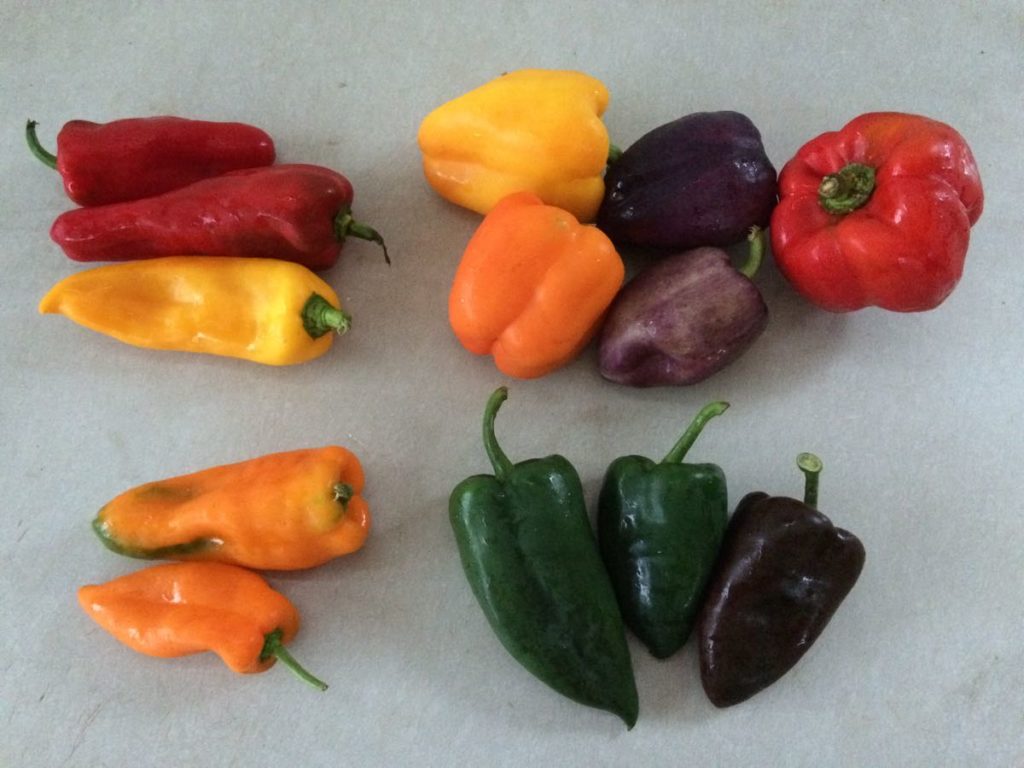
You will receives some of these peppers. I photographed more to help you identify the different types by shape, size and color.
Clockwise from top left;
– Frying peppers (slender; red or yellow; SWEET) – These peppers are thin-walled with low moisture, which allows them to fry readily in hot oil. Excellent raw or cooked.
– Bell peppers (blocky; various colors; SWEET) Bell peppers are thicker-walled and juicy, great for eating raw in salads or roasting on the grill. Your bell pepper this week could be yellow, orange, red or purple. Purple peppers taste like green bells.
– Poblano chiles (triangular, shiny; red or brown; MILDLY HOT) – Poblanos are the creme de la creme of chiles. They have lots of great flavor in combination with manageable heat. Roast and add to soup or casseroles. To reduce heat, remove the seeds and midveins.
– Oranos (slender; orange or orange and green; SWEET) – These are snacking peppers, with excellent flavor and few seeds.
RECIPES
Visit our 2018 Recipe Log or our 2017 Recipe Log or join our Facebook discussion group.
LOCAL THYME/ Comforting Classics
Garlicky Glazed Carrot
Pan Seared Chicken Breasts with Garlicky White Wine Reduction Sauce with Tomatoes
Nigel Slater’s Eggplant Tomato Curry
Peppers Piedmontese
LOCAL THYME/ Outside the Box Recipes
Indian Moong Dal with Carrot and Tomato
Quick Chopped Kalamata Tomato Relish Crostini
Eggplant Falafel
Smoked Trout Salad with Peppers
LOCAL THYME/ Quick and Easy Meal
Poblanos Rajas Scramble
RECIPES FROM LAUREN
GRILLED CARROTS, STEAK & ONION WITH SMOKY FISH SAUCE
Recipe adapted slightly from Six Seasons
I had this at a potluck a few months ago and fell in love with Portland chef Joshua McFadden and his beautiful cookbook Six Season immediately. I think this is probably the fifth or sixth recipe I’ve adapted for you all from this cookbook so if you are loving these recipes, it’s really time you checked it out yourselves. Lauren.
Takes 1 hour.
Serves 4.
1 pound steak (skirt, tri-tip, rib-eye or other cut that’s tasty grilled)
Kosher salt
Freshly ground black pepper
2 pounds trimmed and peeled carrots, split lengthwise into quarters
1 large yellow onion, cut into fat slices
Olive oil
1 or 2 lime wedges
Smoky Fish Sauce:
1/2 cup fish sauce
2 poblanos seeded, de-ribbed and minced
1/4 cup white wine vinegar
4 garlic cloves, minced
2 tablespoons sugar
- Season the steak with 1 teaspoon salt and several twists of pepper then heat a gas grill to medium.
- Prepare your sauce by combining all ingredients in a small bowl and stirring until sugar dissolves then adding 2 tablespoons water. Let sit on counter to marinate while you cook.
- Once preheated, arrange the carrots and onion slices on the grill. Cook, turning every couple minutes, until they are starting to soften and brown a bit (the carrots should be about as soft as a cooked beet, and the onions should be tender and juicy but not yet significantly charred), about 15 minutes.
- Increase the grill heat to medium-high, blot any moisture off the steak, and add it to the grill. Cook to medium-rare, 3 to 5 minutes per side, depending on how thick it is. Leave the vegetables on while cooking the steaks but keep an eye on them to make sure they’re not charring too much. A few dark edges are nice, but take them off if they are getting more blackened than that.
- Take everything off the grill. Let the steak rest as you cut the carrots at an angle into long slices and cut the onion rings in half; they will likely fall apart at this point.
- After the steak has rested for at least five minutes, cut it across the grain into thin strips. Place the steak, carrots and onions into a large bowl and pour on 1/2 cup of the spicy fish sauce (the batch makes more like 2 cups; save the remaining to drizzle over grilled meats, to marinate some chicken, or to use as a dressing for roasted vegetables (particularly poatoes). Also add any steak juices that have accumulated on the resting plate or cutting board to the bowl. Toss, taste, and add more sauce if you need for the flavors to be bright and flavorful.
- Drizzle with olive oil, a bit more salt and pepper, and a few squirts from the lime before serving.
.
VEGETARIAN STUFFED PEPPERS
Takes 1 hour, 30 minutes (only 30 minutes active).
Serves 4-6.
3 tablespoons butter
1 onion, diced
3/4 teaspoon Kosher salt
1/4 teaspoon freshly ground black pepper
1 orano pepper, cut into 1/4-inch dice
1 zucchini, cut into 1/4-inch dice
1 eggplant (if you got one), cut into 1/4-inch dice
2 garlic cloves, minced
2 pounds plum tomatoes, cored, seeded and diced
2 teaspoon cumin
1 teaspoon chili powder
1/2 teaspoon red pepper flakes
1/2 teaspoon dried oregano
1 cup cooked quinoa
1 can black beans
4 red frying peppers, cut in half, seeds and ribs removed
1 bell pepper, cut in half, seeds and ribs removed
1-2 avocados, optional
Sour cream, optional
Hot sauce, optional
Fresh lime juice, optional
- Preheat oven to 375 degrees.
- In a large saucepan, melt butter over medium heat. Add onion, salt and pepper and cook until softened and fragrant, about 5 minutes. Add pepper, zucchini and eggplant (if using) and saute 10 minutes longer. Finally, add garlic and saute until that is fragrant (about 5 minutes more). Stir in tomatoes and spices followed by quinoa and beans. Cook for 5-10 minutes until tomatoes aren’t too liquidy.
- Stuff each pepper half with quinoa mixture. They will likely be heaping. Place peppers with room between them in a 9×13-inch baking dish. Pour a few tablespoons of water into the pan to help steam the peppers. Cover with foil and bake for 30 minutes. Remove foil and bake for 20 minutes more until peppers are soft and lightly browned.
- Serve warm with sliced avocado, sour cream, hot sauce, and/or lime juice.
.
Week #15, August 30/31, 2018
- On: August 29, 2018
 0
0
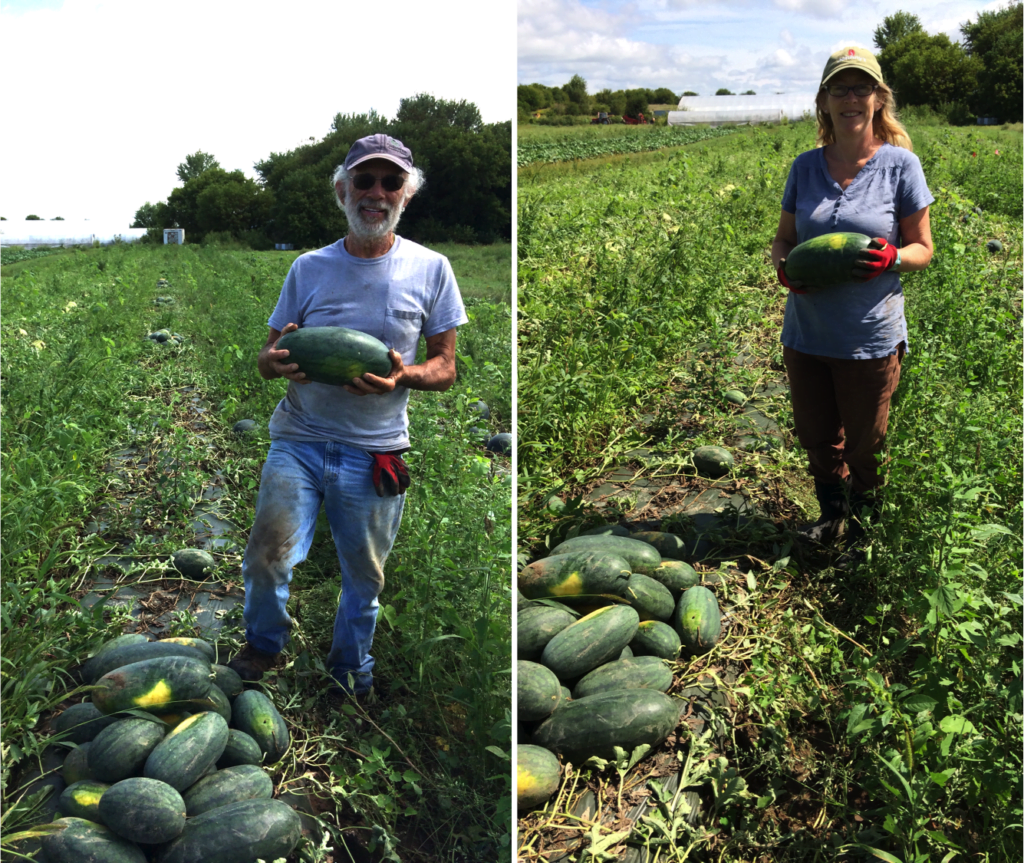
Steve and I picked melons together today, something we do a few times each season and the traditional way to celebrate one’s 20th anniversary. What?? Not everyone celebrates this way? I’m pretty sure 20 years is the “melon anniversary.” “Paper anniversary” for the first year, cotton for the second, etc. We look forward to celebrating our 25th “red pepper” anniversary. Honestly, china and silver are overrated.
It was crazy to get married in late August; we neglect every anniversary. We planned our wedding for August to gather our families in Wisconsin during the summer. It worked well, with a lovely wedding and reception at Folklore Village in Dodgeville. What a beautiful place. The reception was potluck and all our friends brought their best cooking. August was great for the wedding, but now we tend to work right through our anniversary each year. Steve and I will go out to dinner this weekend to celebrate properly, and will be sure to order melon salad. Beth
Farm News and Tomato Update

From our fenceline, this is the view past our neighbor’s prairie and down to the Evansville wildlife area.
Rain continues for us, but not as torrential as last week. We got a mere 1.5 inches this week. Our farm gets wet and muddy but doesn’t flood. There’s good drainage into the broad wildlife area at the northern edge of our farm. We hope you are all faring OK. We watch the flood maps in Madison and across Wisconsin and hope for the best for our friends and CSA members.
This week’s tomatoes are better than last week because of lighter rain. We offered extra slicing tomatoes for sale this week. Our first priority is always to fill the CSA boxes. Once we have 4 or 5 pounds picked for each CSA box, then we can sell extra tomatoes to members. We might have extra plum tomatoes to sell next week. Those are in good shape. Watch for emails from us next Tuesday/Wednesday (Thursday sites) or Wednesday/Thursday (Friday sites).
We are not going to host a tomato upick this summer. First, we need to conserve the tomatoes for the CSA boxes. Second, they are a difficult pick this year. Leave this harvest to the professionals. We’ll try again next season.
Veggie List and Veggie Notes
Week #15, Aug 30/31, 2018
– weekly shares
– green EOW
It’s a salsa box!
Sweet corn, 9 – 10 ears
Watermelon, red (most sites) or yellow (2 sites)
Slicing tomatoes, ~5 lb
Romaine lettuce, 1 medium
Colored bell peppers, 2
Red frying OR Oranos peppers, 2
Zucchini/ squash, 1 small (most sites)
Red onions, 1 or 2
Jalapeno chile (HOT), 1
Cilantro, 1 bunch
Garlic, 1 bulb
Next week’s box will probably contain tomatoes, peppers, zucchini, carrots, onions, Romano beans, and more.
Sweet corn – This Steve’s favorite variety again, “Vision.” Most ears have worms at the tip, following a big moth migration. When corn is likely to have worms, I just cut the tips off the ears before husking. It makes handling the corn more pleasant.
Watermelon – Most sites get a small red watermelon, a variety called “Dark Belle,” bred to produce personal-sized melons. This is a great size for CSA when the boxes are so full. One or two sites get a yellow watermelon instead.
Garlic – The first garlic!
RECIPES
Visit our 2018 Recipe Log or our 2017 Recipe Log or join our Facebook discussion group.
LOCAL THYME/ Comforting Classics
Simmered Tomato and Jalapeño Salsa
Vegetarian Tortilla Soup
Refried Bean and Corn Enchiladas
Tomato, Ham, Cheese Omelette
LOCAL THYME/ Outside the Box Recipes
Spiced Shrimp with Corn Cakes
Watermelon, Corn and Black Bean Salsa
Snapper Veracruz
North African Roasted Vegetable Salad
LOCAL THYME/ Quick and Easy Meal
BLT
Recipes from Lauren
GRILLED VEGETABLES WITH SWEET CORN POLENTA
Serves 2 as a meal or 4 as a side.
Takes 30 minutes.
1 red onion, peeled and cut into 1/2-inch wide slices
2 tablespoons olive oil, divided
1-1/2 teaspoon Kosher salt, divided plus more to taste
1/4 teaspoon freshly ground black peppers
3 red peppers (a mix of fryers and bells is fine)
2-3 tomatoes, cored and diced
2 tablespoons butter
2 garlic cloves, minced
1 jalapeno, seeded and diced
1 cup whole milk
1 cup water
1/2 cup cornmeal
2-3 ears of corn, kernels removed
1 tablespoon maple syrup
1/2 tablespoons red wine vinegar, plus more to taste
1/4 cup chopped cilantro, optional
- Preheat your grill to medium high heat. Alternatively, if you don’t have a grill, preheat the broiler of your oven.
- In a medium bowl combine onion with 1 tablespoon olive oil, 1/2 teaspoon kosher salt and pepper. Toss gently to combine. Place on preheated grill. Also place whole peppers on grill (no oil or seasoning necessary). Grill for 15-20 minutes until onions are charred on both sides and peppers are blackened on all sides. The onions may get done first but probably just 4-5 minutes before.
- Meanwhile, get your polenta going. You can easily walk away from your grilling veggies for 5 minute intervals to do this inside, but if you have a burner on your grill, by all means use that to make the polenta!
- Melt butter in a medium sauce pan over medium low heat. Add garlic, jalapeno and remaining salt. Cook until fragrant and softened, about 5 minutes then add milk and water. Turn burner to medium high and continue cooking mixture until it just begins to get foamy. (This should take about five minutes. Watch the pot carefully at this time since once it gets foamy, the mixture quickly rises to the top of the pan). Remove the pan from the burner and turn it to medium low. Slowly add the polenta to your pot, stirring with a metal whisk as you go. Return to burner and cook for 10 minutes, whisking occasionally. Add corn and cook 5 minutes longer.
- Remove grilled onions to the same bowl you prepped them in. Add peppers once charred and cover bowl with a plate for 5 minutes. Remove skins from peppers followed by tops and sides. Roughly chop the peppers and return to bowl. Add remaining tablespoon olive oil, maple syrup and vinegar. Toss to coat.
- Serve polenta warm with diced tomatoes, and grilled veggies. Sprinkle with cilantro if using. Taste and adjust flavors as desired. I added a little more balsamic and salt.
.
TOMATO PIE
Takes 2 hours (a little more if making the crust from scratch)
Serves 4-6
1 batch favorite store-bough pie crust (or make your own; my favorite tomato pie crust is here)
4-5 pounds tomatoes
2 tablespoons butter
1 red onion, sliced
4 garlic cloves, minced
1/2 teaspoon kosher salt
1/4 teaspoon freshly ground black pepper
1/2 cup mayonnaise
1-1/2 cups shredded havarti (or other favorite cheese to pair with tomato; something simple like cheddar or swiss would work just fine)
1/4 cup finely grated Parmesan
1 teaspoon dried thyme
3 pieces cooked, thick-cut bacon
1. Preheat oven to 475 degrees.
2. If making your crust from scratch, get this going first so it has plenty of time to chill in the freezer. If not, hop to step 3.
3. Core and cut tomatoes into 1/4-inch slices. Lay tomato slices on two large baking sheets so that they overlap slightly but are mostly in a single layer. This may take four pounds of tomatoes or it may take five depending on how thick your slices are. Drizzle with olive oil (probably a tablespoon or two for both pans) and sprinkle with salt and pepper. Roast in preheated oven for 45 minutes until the tomatoes look dehydrated and most of the liquid has evaporated.
4. Then, work on preparing your filling. In a large saute pan, melt butter over medium heat. Add onion and saute for five minutes until softened. Add garlic and continue cooking for 20 minutes until onions are beginning to caramelize.
5. In a medium bowl, combine mayonnaise, havarti, parmesan, thyme and bacon. Stir until smooth. Once onions are done cooking, add those to the mix. Stir to combine.
6. By now your tomatoes should be done cooking. Remove them from the oven and reduce the temperature to 375 degrees. Roll out the crust and place in a 9 or 10-inch pie pan. Place aluminum foil and pie weights (or rice or dried beans) inside and bake for 15 minutes.
7. Remove crust from oven. Pour onion mixture over the bottom. Add sliced roasted tomatoes and bake for 45- 55 minutes until the crust is golden. Let cool at least 5 minutes before devouring.
.


